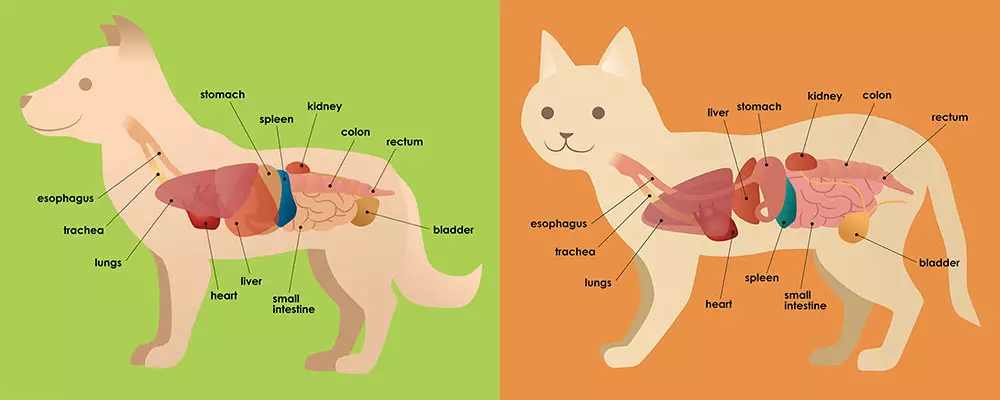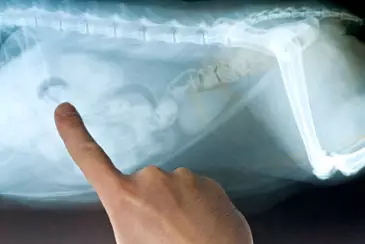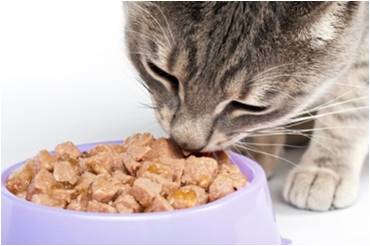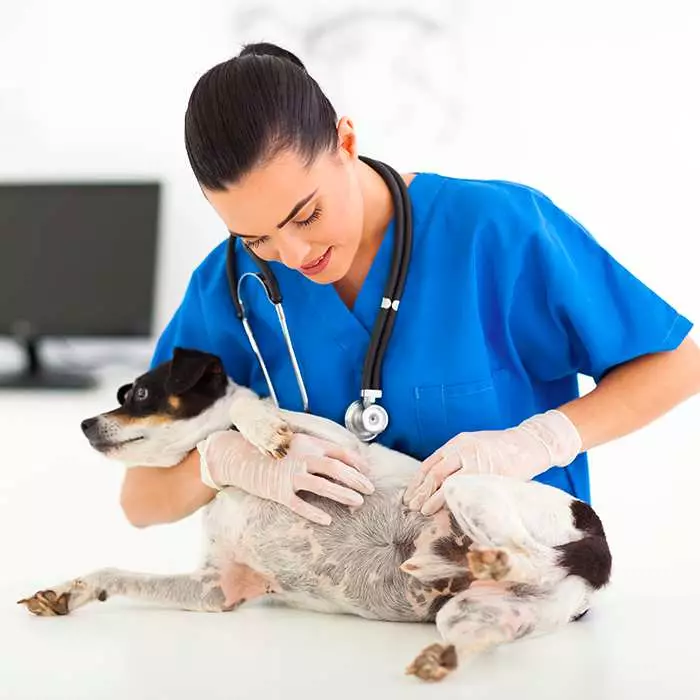Renal (kidney) disorder in dogs and cats
What is renal (kidney) disorder?
The word ‘renal’ means relating to the kidneys. The kidneys are two bean-shaped organs that remove waste and excess fluid from the body. They are part of the urinary system along with the ureters (tubes that connect the kidneys to the bladder), the bladder, and the urethra (the tube through which urine exits the body). The kidneys in dogs and cats are located within the abdomen just below the spine, above the bladder.
The kidneys perform many vital functions, including:
- Filtering the blood to remove waste materials from food, medication and toxins
- Regulating and filtering minerals from the blood
- Maintaining fluid balance (body water, salts and acids)
- Creating hormones that assists in red blood cell production
- Aiding calcium metabolism, thereby promoting bone health
- Regulating blood pressure
Kidney disorders in dogs and cats can occur when one or more of these functions are compromised. When the kidneys don’t function properly, toxins build up in the blood and illness can follow quickly. Unfortunately, this often goes undetected until the kidneys are functioning at around a quarter to a third of their capacity.
Kidney disorders occur more frequently as animals age. It is estimated that more than 1 in 10 dogs will develop kidney disease over a lifetime. This condition is even more common in cats, occurring in more than half of cats over age 15. Kidney disease is a leading cause of suffering and death in cats because it is often not detected until too late.

Kidney disease can be subdivided into two types:
Chronic kidney disease (CKD)
When the level of kidney function declines slowly (chronically), animals may be able to compensate for months or even years. Mild signs of illness and dehydration will progress as the disease worsens. CKD is very common in older pets, affecting approximately 3 in 10 geriatric cats . By the time the symptoms of kidney failure in dogs or cats are obvious, it can be too late to treat the condition effectively.
Acute kidney disease
Acute kidney failure is an abrupt decline in function that occurs over a period of days. If an animal suffers a severe or abrupt injury to the kidneys, urine production may cease, which can lead to profound illness and even death.

Source: https://gordonvet.com.au/wp-content/uploads/2015/11/img_illust_normalCanineKidney_en.jpg
Symptoms of renal (kidney) disorder in dogs and cats
Symptoms of kidney disorders in dogs and cats often occur gradually over an extended period of time. Many animals show no outward signs of kidney disorders until the condition is very advanced, and even when they do, the first signals are easy to miss.
Some of the earliest signs of kidney failure in cats and dogs are more frequent urination and drinking. The animal may need to urinate at night or may have “accidents”. Unfortunately, once signs are present, a great deal of kidney damage may already have occurred.
Some of the more common symptoms of moderate to severe renal disorders include:
- Vomiting
- Lethargy
- Diarrhoea
- Constipation
- Dehydration
- Depression
- Weight loss
- Increased thirst
- Loss of appetite (anorexia)
- Acute blindness
- Seizures and comas
- Blood in the urine (haematuria)
- An increase in the frequency and volume of urination
- Urinary incontinence (leakage)
- Chemical odour to the breath
- Mouth ulcers
- Pale gums
- Stumbling, acting drunk
Causes of renal (kidney) disorder in dogs and cats
Chronic kidney failure in dogs and cats develops slowly and affects mostly older animals. It is typically caused by underlying illness and congenital and hereditary conditions.
Underlying illnesses causing chronic kidney failure in dogs and cats can include:
- Kidney infection (pyelonephritis)
- Diabetes mellitus
- Dental disease
- High blood pressure
- Cancer
Risk factors that can increase the likelihood of kidney disease occurring include:
- Age – older animals are more susceptible
- Breed – some breeds, including Bull Terriers and English Cocker Spaniels, have a higher risk of chronic kidney disease.
- Feline infectious peritonitis (FIP)
- Amyloidosis (a genetic condition found in Abyssinian, Siamese, Oriental breeds)
- Polycystic kidney disease (a genetic disease occurring particularly in Persian cats)
Acute kidney failure can be brought on by:
- Urinary blockage (obstruction of the urinary tract or of the ureters)
- Kidney stones (nephrolithiasis)
- Decreased blood flow or oxygen delivery to the kidneys
- Certain prescription medications
- Ingesting toxins / poisons (e.g. antifreeze, tainted foods, certain plants, pesticides, cleaning fluids, certain human medications)
- Infection in the kidneys
- Trauma
How is renal (kidney) disorder in dogs and cats diagnosed?
The earlier the diagnosis is made, the better the chance to find and treat an underlying cause or to slow progression and enable the animal to feel well for as long as possible.
Diagnostic testing may include:
Physical Examination
The examination, which will include careful abdominal palpation, may reveal:
- Irregular size and shape of the kidneys (either too large or too small)
- Renal asymmetry (one big and one little kidney)
- Painful kidneys
- Stones in the urinary pathway
- Back or flank pain
- Changes in the prostate or urinary bladder
A rectal examination can provide more detail about the possibility of urethral, bladder or prostatic disease that might relate to kidney disease. Other, less specific findings may also warn the veterinarian about a kidney problem, including:
- An enlarged bladder in a dehydrated animal
- Low body temperature
- Weight loss
- Dry gums (showing dehydration)
- Unkempt hair coat
- Mouth ulcers and/or bad breath
- Eye or vision problems associated with high blood pressure
Further diagnostic testing may include:
- Complete blood count (CBC)— may reveal anaemia (too few red blood cells) or an elevation in white blood cells consistent with infection, stress or inflammation; less commonly, blood parasites or circulating cancer cells are found.
- Chemistry profile with electrolytes – abnormal electrolyte levels are common with chronic renal failure.
- Urinalysis with sediment exam — a microscopic examination of urine that has been centrifuged to concentrate the substances in the urine at the bottom of a tube.
- Urine culture with susceptibility – to determine which antibiotics will inhibit the growth of any microbes causing infection.
- Urine protein to creatinine ratio (UP:UC) – used to provide an estimate of the amount of protein lost in the urine.
- Diagnostic imaging—radiography (x-rays) and diagnostic ultrasound can identify changes in the size, shape and architecture of the kidneys or may suggest a specific blockage that needs emergency treatment.
- Blood pressure measurement—high blood pressure is common with chronic kidney disease.
- Kidney sampling – a biopsy involves taking one or more tiny pieces (samples) of the kidney examine with special microscopes.
- Infectious disease testing— can identify risk factors for kidney disease, e.g. routine testing of sick cats for feline leukaemia virus (FeLV) and feline immunodeficiency virus (FIV), regular testing for heartworm infection and for vector borne diseases such as Ehrlichiosis and Lyme.
- Thyroid testing—Hyperthyroidism can mimic or mask signs of kidney disease and frequently affects older cats.
Prognosis
Chronic renal failure is a progressive disease. Prognosis will depend on the severity of the disease and its stages of progression. With early diagnosis and treatment, some dogs and cats with chronic kidney disease can live for some years and have a good quality of life, as long as the kidneys retain some functionality. If undiagnosed or left untreated, however, end-stage kidney failure will occur, leading to death.

Treatment for renal (kidney) disorder in dogs and cats
While chronic renal failure in dogs and cats cannot be reversed or cured, treatment and management can improve and prolong the animal’s life. Treatment is aimed at reducing the contributing factors and symptoms. Treatment options can range from surgery to remove blockages, to IV fluids, to a special diet and medications.
It is important to identify kidney failure and begin treatment as early as possible. Treatment options for advanced kidney disease are usually limited to treating the symptoms because dialysis and kidney transplants are not readily available for dogs and cats.
Depending on whether the problem is acute or chronic, treatment may include the following:
- Drugs that encourage urine production
- Fluid therapy, to correct dehydration
- Management of blood electrolyte abnormalities (balancing acid/alkaline levels)
- Monitoring of urinary output
- Control of vomiting
- Medication for gastrointestinal problems
- Dialysis (where available)
- Dietary management
- Correction of anaemia
- Management of high blood pressure
- Therapy for any specific underlying causes identified (example: antifreeze toxicity, infection)
Ongoing management of dogs and cats with kidney disorders may include:
- Ensuring the animal does not have access to potentially dangerous substances
- Supervising the animal at all times when outside
- Avoiding any over-the-counter medications without instruction by your veterinarian
- Ensuring that the animal has access to fresh water at all times and encourage frequent drinking
- Providing proper oral hygiene to help maintain good overall health
- Providing adequate and appropriate nutrition with a kidney friendly diet, which is typically low in phosphorus and protein, and enriched with vitamin D and omega-3 fatty acids (always check with your veterinarian before making any dietary changes).
- Scheduling frequent check-ups by your veterinarian to ensure that the medications and diet are optimal for the disease stage.

In summary
The kidneys perform many important functions in the body. Kidney disorders occur when the kidneys’ functionality is compromised, allowing toxins to build up and other problems to occur. This process can take place over months or even years, and by the time the symptoms of kidney failure are obvious, it may be too late to treat the condition effectively.
Some of the earliest signs of kidney disease in dogs and cats are more frequent urination and drinking. There are several risk factors that can make animals more susceptible to kidney disease, such as old age or certain breed types. Other risk factors like kidney stones, urinary tract infections or other diseases could make kidney problems more likely.
Although there is no cure for chronic kidney failure, there are numerous treatment options that can minimise the symptoms and slow the progression of the disease, including medication, fluid therapy and dietary modification. Prognosis will depend on the severity of the disease and its stages of progression, but with proper treatment, a few years of stability can be achieved.
Bow Wow Meow Pet Insurance can help protect you and your pet should an unexpected trip to your vet occur.
- Find out more about our dog insurance options
- Find out more about our cat insurance options
- Get an instant online pet insurance quote


More information
- https://pets.webmd.com/dogs/kidney-problems-in-dogs#1
- https://pets.webmd.com/cats/kidney-failure-uremia-symptoms-cats#1
- http://www.pethealthnetwork.com/dog-health/dog-diseases-conditions-a-z/chronic-kidney-disease-what-does-kidney-failure-dogs-really
- http://www.pethealthnetwork.com/cat-health/cat-diseases-conditions-a-z/chronic-kidney-disease-what-does-kidney-failure-cats-really
- http://www.pethealthnetwork.com/cat-health/cat-diseases-conditions-a-z/kidney-disease-in-cats-what-cat-owners-should-know
- https://www.petmd.com/dog/conditions/urinary/c_multi_renal_failure_chronic
- https://www.petmd.com/cat/conditions/urinary/c_ct_renal_failure_chronic
- http://www.theveterinaryexpert.com/kidney-problems/kidney-disease-in-dogs/
- https://www2.vet.cornell.edu/departments-centers-and-institutes/cornell-feline-health-center/health-information/feline-health-topics/chronic-kidney-disease









